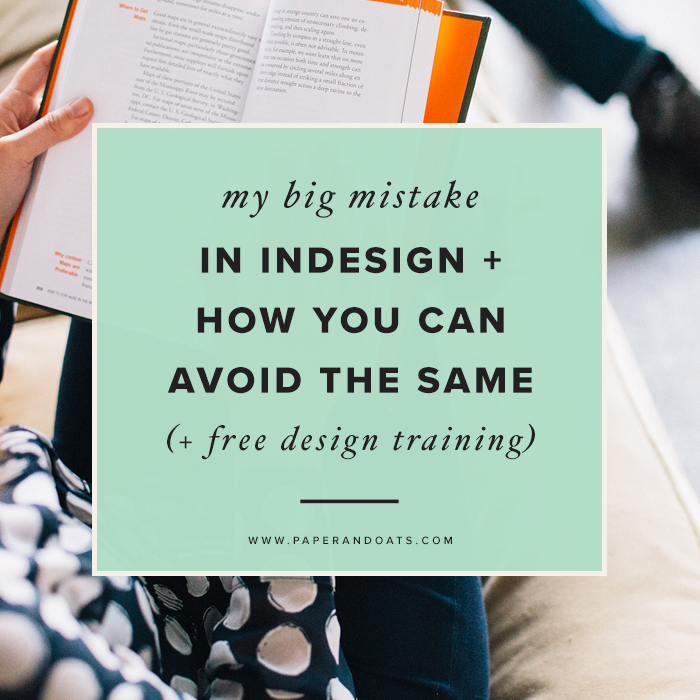In 2010, I was a poor college student. My design classes were boring me, and I just wanted to dive into some real client work. My brother’s business was just taking off, and he quickly turned to me for design work as his business developed. One day, he called me up and told me about a book he was wanting to write. Then he asked me if I would design it – cover, interior layout, all of it. I immediately knew three things:
Adobe InDesign was the program to use for this type of multi-page project.
I had never opened InDesign on my computer. Like, never ever clicked it. Ever.
I was a fast learner.
So I pulled a fake-it-til-you-make-it, and answered, “Sure [insert insulting sibling nickname], I can design your book for you.” Gulp.
I hung up the phone, and immediately searched through my computer to find InDesign. Again, literally had never used it – note to self: probably not the best idea to accept a project requiring a program you’ve never even opened!
So I started on his book, figuring out things as I went, and let me tell you, it took a l-o-o-o-o-n-g time! By trial and error, I painstakingly made my way through all 200 pages of his book. I didn’t know how to use the character styles or paragraph styles, so I edited all the typography manually – huge time sucker! I didn’t know how to set up master pages, so I added running heads and page numbers one page at a time – what was I thinking?! It took me a good hour to figure out how to add his logo to one of the back pages – now I know it takes about 10 seconds.
But I finally figured it all out after hours upon hours of doing things the long way. I was so proud of myself for laying out this entire book, start to finish. Well, almost finish. We were ready to prep the files for print… enter the biggest mistake of all.
One of the requirements from the printer we were using was to convert all the text to outlines. I know now that I could have just exported an InDesign package with all links and fonts used, and that would have sufficed. But I was a newbie. Without thinking, I foolishly highlighted all the text in the entire book, clicked convert to outlines, saved it, and closed the file.
NOOOOO!!!!!!!
If you don’t realize my mistake, here it is: converting text to outlines makes the text uneditable. If you have to do this to prep for print, you should either save it as a separate file or undo the outlines before you save and close your file. You should NEVER save your file with the text outlined, because you’ll never be able to go back and edit that text. So for an entire book that my brother was planning to keep updated and print for many years to come, this was a disaster. I quickly realized my mistake, and spent hours researching how to undo it. This was long before I had Time Machine or backed up my files, or anything professional designers should be doing now to save themselves from these types of mistakes. So heads up designers – back up your files!
Long story short, I never found a solution, and ended up hacking my way through 6 more updated editions of the book over the next few years. I retyped entire pages by hand in order to change one small word (copying + pasting from the original manuscript wasn’t an option because we had made edits after laying out the book). It was the biggest pain, and I felt so unprofessional every time I had to explain to a printer that no, I didn’t have the original file. Thankfully my client was my brother and he didn’t completely hate me – and even kept working with me – thanks Grant! :) But every time I opened that outlined InDesign file, it was a clear reminder of the huge mistake I had made.
So what can you learn from my mistake?
1. Fake it till you make it only works up to a certain point.
I agreed to complete a project using a program I had never opened. That was risky. Luckily I was able to figure it out as I went and it would have turned out ok, but that last critical mistake almost ruined all of it. I could only fake it to a certain point, and then I had to admit to myself and to my client that I wasn’t properly prepared for that project. If you’re a creative entrepreneur, sometimes you have to fake it till you make it in the beginning stages of your business. This is fine for a season as you’re learning the ropes of your industry, but taking that route for too long can be dangerous and risky, especially if you start taking on larger projects with bigger clients.
2. Be honest with your clients if you get in over your head.
I got lucky, and my client that took the brunt of my huge mistake was my brother. If it had been a regular freelance client, I probably wouldn’t have been asked to worth with them again. But either way, I chose to be honest with my client right away and tell him I got in over my head with this mistake. He was understanding that I was a newbie, and I made sure to keep the lines of communication open and honest about how we could fix the issue.
3. Learning new tools for your trade can open up new opportunities.
Though my journey was through hours and hours of trial and error, once I finally knew how to use Adobe InDesign, I had a new skill I could use to market myself for freelance clients and even for real jobs. No matter your industry, staying current with the standard tools that are used allows you to accept opportunities that come your way. As a creative entrepreneur or self-taught designer, you have to continue educating yourself on new products and tools to stay relevant and successful. Clients want to grow their businesses, so they’re exploring new projects and services to do that. As a professional yourself, you have to do the same thing with your skills and abilities to keep up with them.
And what's this about a special announcement?
Fast forward 5 years, and I’ve laid out over 20 published books and countless other projects like PDF guides, newsletters, booklets, catalogs, worksheets, sales pages, brochures, and other text-heavy projects using InDesign. And I don’t go near that Convert to Outlines button now :) All this leads up to a very exciting announcement that I’ve been waiting months to share with you. It’s been a long time coming and I’m finally getting out of the planning phase and into the actual creating phase, and I’m ready to share it with YOU!
Later this year (2015), I’ll be launching a brand new online learning experience called The InDesign Field Guide. This practical, self-paced online course will teach you — a short-on-time creative entrepreneur — the essential tools to start using Adobe InDesign like a pro. With The InDesign Field Guide, you'll learn how to use InDesign to create digital products, books, e-books, style guides, presentations, publications, and other text-driven designs for yourself or your clients; standard typesetting and layout principles; my tips & tricks to work smarter in the software; plus how to integrate Photoshop + Illustrator with InDesign to produce professional designs you can be proud to share.
Head over here to read all about the InDesign course!
Want to learn how to use InDesign, like NOW?
My FREE InDesign Cliff Notes is quick-start guide + video tour to get your feet wet with Adobe InDesign. Learn what InDesign is best used for, how it works, and how you can learn it FAST. I created this beginner’s InDesign guide with YOU in mind, and I think you'll see how not-scary InDesign really is. 😉Signup below, I’ll send you the full guide right now!
Your Turn
Have you ever tried to teach yourself a skill and it totally back-fired? Have you ever wanted to learn InDesign? What types of tools are you most interested in learning about in the software?








